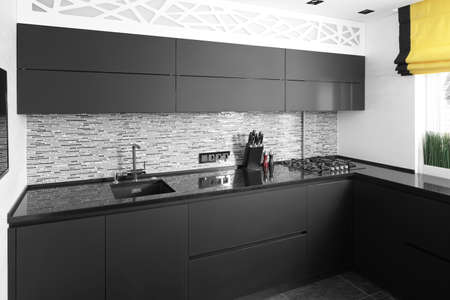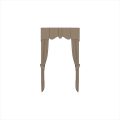Embracing Minimalism in the British Kitchen
In recent years, the modern British household has seen a quiet revolution in kitchen design. More and more homeowners are embracing minimalist principles, turning away from cluttered countertops and ornate cabinetry to create spaces that breathe simplicity and functionality. The essence of this movement lies in clean lines, neutral palettes, and open layouts that make even the most compact kitchens feel bright and inviting. Yet, what sets the British approach apart is its sensitivity to heritage; rather than stripping away all character, minimalist kitchens here often retain classic features like shaker doors or a hint of exposed brick, blending old-world charm with contemporary ease. This fusion allows for a kitchen that feels both timeless and utterly liveable—a space designed as much for morning tea as it is for bustling family dinners. By thoughtfully decluttering and focusing on purposeful design choices, British homes are proving that minimalism need not mean sterility; instead, it’s about creating a calm, collected heart of the home where form meets function in perfect harmony.
Key Elements of a Modern Minimalist Kitchen
When it comes to modern minimalist kitchens in the UK, there are several defining features that set the tone for both style and function. At the heart of this design philosophy is the pursuit of simplicity, but not at the expense of warmth or practicality. Let’s take a closer look at the essential elements that make up a streamlined British kitchen.
Muted Colour Palettes
The British approach to minimalism leans towards understated elegance, often reflected in soft, muted colour palettes. Think shades of warm grey, gentle taupe, off-white, and even sage green or navy blue for subtle accents. These hues create a calm backdrop, making spaces feel airy and inviting—perfect for city flats or countryside homes alike.
Clever Built-In Storage
With space often at a premium in British homes, efficient storage solutions are key. Modern minimalist kitchens feature built-in cabinetry that maximises every inch, from deep drawers for pots and pans to pull-out larders and hidden recycling bins. This focus on organisation helps keep worktops clutter-free and creates an effortlessly tidy atmosphere.
| Storage Feature | Benefits |
|---|---|
| Pull-out Larder | Easy access to dry goods, uses narrow gaps efficiently |
| Integrated Bins | Keeps waste out of sight, supports recycling habits |
| Corner Carousels | Makes use of tricky corner spaces for storing cookware |
| Deep Drawers with Dividers | Organises utensils and pans for quick access |
Streamlined Cabinetry & Integrated Appliances
Sleek cabinetry with handleless doors or discreet hardware offers a seamless visual flow—a hallmark of contemporary British taste. Integrated appliances such as fridges, dishwashers, and ovens blend into the cabinetry, maintaining clean lines while supporting modern living needs. This integration is not just about aesthetics; it also reflects a desire for easy maintenance and efficient use of space.
Why These Choices Reflect Contemporary British Taste
The emphasis on muted colours and smart storage echoes a national appreciation for practicality combined with subtle sophistication. British minimalism values homes that are welcoming yet orderly—a place where everyday life feels both relaxed and refined. By blending form and function so seamlessly, modern minimalist kitchens truly capture the best of contemporary British living.

3. Blending Tradition with Innovation
One of the most captivating aspects of modern minimalist kitchens in Britain is the way they harmoniously blend cherished tradition with contemporary innovation. It’s not about erasing history, but rather honouring it while making room for streamlined living. Classic British features—think the sturdy Belfast sink or the ever-reliable Aga stove—bring a sense of warmth and continuity, acting as subtle nods to the past even in the most forward-thinking spaces. These iconic elements anchor the kitchen, providing both character and a connection to family rituals and Sunday roasts gone by.
Yet, alongside these beloved staples, there’s a growing appreciation for sleek cabinetry, handleless units, and open shelving that maximises both light and space. Modern British minimalism isn’t cold or clinical; instead, it’s soft-edged and practical, making clever use of natural light through large windows or skylights, and employing pale woods or crisp whites to keep things airy and inviting. This approach allows homeowners to enjoy efficient layouts without sacrificing comfort or heritage. By carefully selecting which traditional elements to highlight—and letting them shine amidst streamlined surfaces—the result is a kitchen that feels fresh yet unmistakably British: a true blend of legacy and innovation.
4. Smart Storage for Smaller British Spaces
One of the defining features of modern British homes is their compact kitchen layouts. Maximising every inch is essential, especially when striving for a minimalist aesthetic that doesn’t sacrifice functionality. Here are practical strategies to help you create a streamlined, clutter-free space tailored to everyday British living.
Vertical Storage Solutions
When floor space is at a premium, think upwards. Tall cabinets, open shelving above countertops, and wall-mounted racks allow you to store more without crowding your work surfaces. Consider using the space above your fridge or doorways—ideal spots for seldom-used items like seasonal bakeware or serving dishes.
Multi-Purpose Furnishings
Furniture that works double duty is a cornerstone of minimalist design in the UK. Opt for extendable tables, benches with built-in storage, or kitchen islands on wheels. These pieces flexibly adapt to your needs—whether it’s a quick breakfast, family dinner, or impromptu workspace—while keeping essentials hidden away.
Hidden Compartments Tailored to British Lifestyles
Bespoke cabinetry solutions can be game-changers for small kitchens. Think pull-out spice racks next to the hob, deep drawers for pots and pans, or slimline larders tucked into narrow spaces. Integrated bins and recycling units also help maintain the clean lines of a minimalist design.
Compact Kitchen Storage Ideas Table
| Storage Solution | Description | Best For |
|---|---|---|
| Pull-Out Larder | Narrow pantry unit with shelves that slide out smoothly | Condiments, tins, and dry goods |
| Overhead Open Shelves | Shelves mounted above counters or appliances | Crockery, glassware, cookbooks |
| Bench Seating with Storage | Lidded benches doubling as seating and storage chests | Pots, table linens, cleaning supplies |
| Corner Carousels (Lazy Susans) | Rotating trays fitted inside corner cupboards | Pans, baking equipment, mixing bowls |
| Integrated Bin Drawers | Bins concealed within base units for waste and recycling | Keeps refuse out of sight; easy sorting for UK recycling schemes |
| Magnetic Wall Racks | Magentic strips fixed to walls for knives and utensils | Saves drawer space; keeps tools within easy reach |
A Practical Note on Decluttering British Kitchens:
To truly embrace the modern minimalist look, regularly audit what you use most often. Donate duplicate gadgets or crockery to charity shops—a very British way to give back while keeping your kitchen streamlined. With thoughtful storage choices and a touch of creativity, even the smallest UK kitchens can feel spacious, organised, and effortlessly stylish.
5. Sustainable Materials and Local Flair
Modern minimalist kitchens in the UK are not just about clean lines and decluttered spaces—they’re also increasingly about mindful choices that respect both the environment and local culture. By opting for eco-conscious materials, such as sustainably sourced British timber or recycled glass, homeowners can create kitchens that are as responsible as they are refined. The integration of vintage finds—think reclaimed Welsh slate worktops or an upcycled Belfast sink—adds a layer of story and character to the space, ensuring each kitchen feels uniquely personal while treading lightly on the planet.
Embracing Local Craftsmanship
Supporting local artisans and manufacturers is a hallmark of the British approach to minimalism. From handcrafted cabinets in soft, natural hues to bespoke brass hardware made in Sheffield, choosing British-made pieces not only reduces carbon footprint but also celebrates regional skills and traditions. These subtle details infuse your kitchen with a quiet sense of place, making it feel grounded and authentically yours.
Vintage Meets Modern
Incorporating vintage elements into a minimalist kitchen doesn’t mean sacrificing modern functionality. Instead, blending old with new—a salvaged wooden dining table paired with sleek contemporary chairs—strikes a perfect balance between comfort, practicality, and style. This curated mix tells a story of sustainability: giving new life to quality items instead of buying mass-produced alternatives.
A Forward-Thinking Aesthetic
Ultimately, choosing sustainable materials and celebrating local flair elevates the modern minimalist kitchen from purely functional to meaningfully beautiful. It’s about creating a space that looks ahead while honouring what’s close to home—a true reflection of contemporary British values in design.
6. Everyday Practicality: Life in a Minimalist Kitchen
Step into a modern minimalist kitchen and youll notice it’s more than just aesthetics—it’s about making daily life easier, the British way. Imagine starting your day with a quick cuppa; everything you need for that morning brew is at arms reach, tucked away neatly yet always accessible. The kettle sits ready on an uncluttered counter, mugs are stacked behind a smooth cabinet door, and the tea caddy has its own discreet corner. There’s no rummaging or wasted time—just the simple pleasure of a peaceful morning ritual.
As the day unfolds, the streamlined setup continues to work its quiet magic. Lunch preparations are effortless when pans, utensils, and ingredients have dedicated homes. The classic British toastie or jacket potato becomes even more inviting when all tools are within easy reach, thanks to clever pull-out drawers and well-thought shelving. Everything is pared back to essentials, but nothing is missing.
Come Sunday, when it’s time for a proper roast, the practicality of a minimalist kitchen truly shines. With clear worktops and integrated storage, there’s space to prep veg, season the joint, and get Yorkshire puds rising without crowding or chaos. Roasting tins slide out from their designated spot; herbs and spices are lined up in an orderly drawer. Even as the oven warms and aromas fill the air, cleaning as you go is second nature—surfaces are easy to wipe down and clutter never has a chance to accumulate.
This is where British minimalism stands apart: it values both tradition and efficiency. There’s respect for rituals like afternoon tea or family dinners, but every step is made smoother by thoughtful organisation. Appliances are chosen for reliability and stowed for tidiness; everyday crockery is kept at the front while special-occasion serveware waits patiently behind closed doors.
Ultimately, living with less doesn’t mean sacrificing those small comforts that make British kitchens so beloved. Instead, it means each cup of tea and every hearty meal can be enjoyed with less fuss and more satisfaction—a true celebration of everyday practicality in a uniquely British minimalist home.


